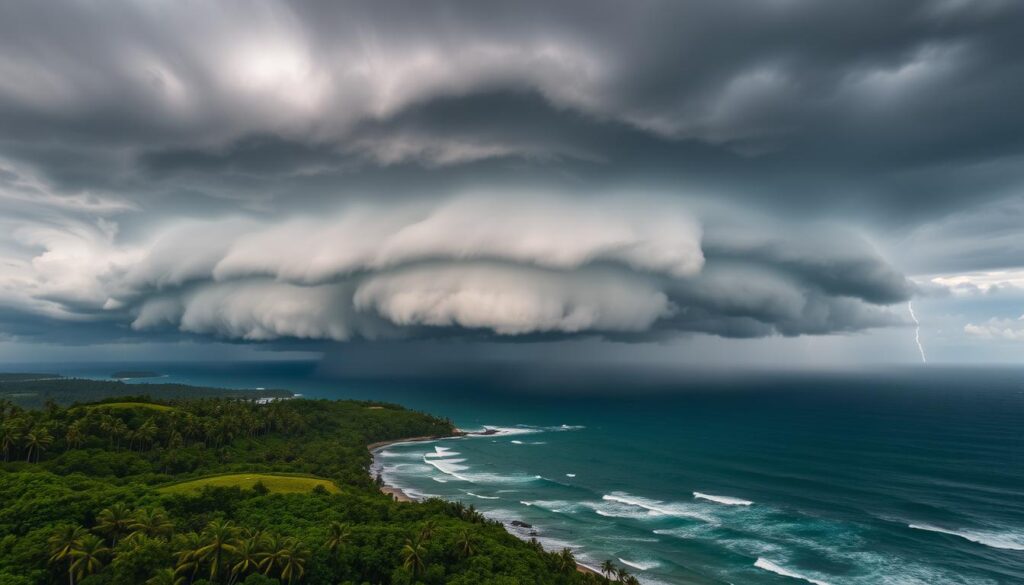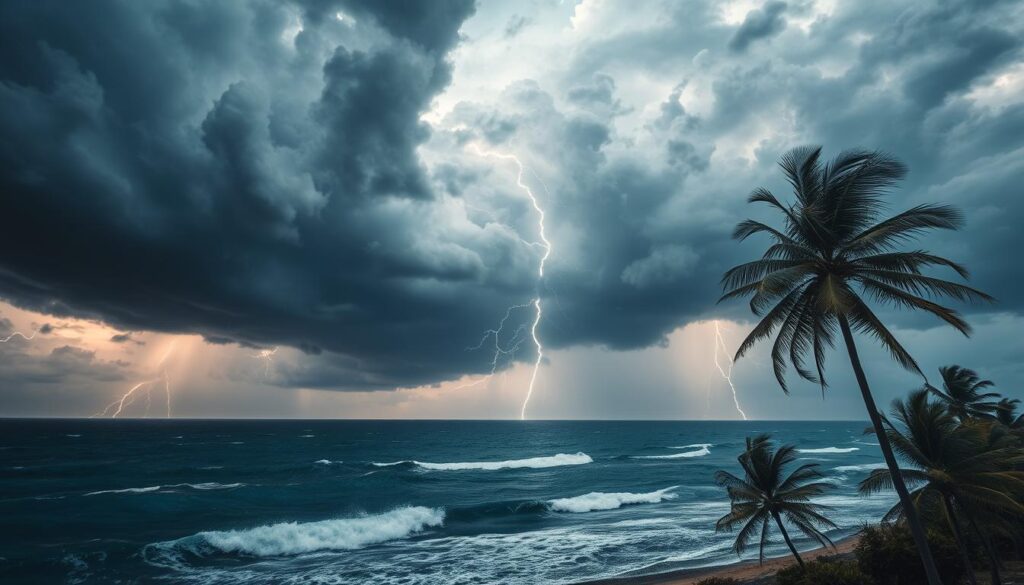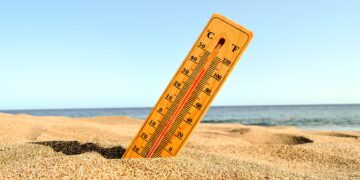As a tropical storm forms in the Atlantic, it’s crucial to stay informed about its progress and potential impacts, especially for those living in affected regions or planning to travel. One of the most recent developments is Tropical Storm Isaac, which is currently making waves across the central subtropical Atlantic. Below, we break down what to expect from this storm, how to stay safe, and what travellers and residents in affected areas should be aware of.
Tropical Storm Isaac: What to Expect and How to Prepare
Weather experts are closely watching Tropical Storm Isaac for the latest news. Isaac is expected to get stronger, posing a threat to areas far from the coast. We are currently following the First Warning Meteorologists to bring you important updates.
Isaac could become a Category Four storm, with winds over 130 mph. This is a serious warning for everyone.
The storm’s impact will be huge, with winds affecting a wide area. Chris Martinez, a top meteorologist, has issued a severe weather alert. He says Isaac could hit Florida’s Gulf Coast and even reach Tennessee and Indiana.
South Florida is already under Tropical Storm warnings. It’s crucial to prepare for emergencies right away.

Key Takeaways
- Projections see Tropical Storm Isaac escalating to a Category Four hurricane prior to landfall.
- Isaac touts an expansive wind field, measured to impact regions distant from the Gulf’s shores.
- Officials in Palm Beach County among others are preemptively establishing emergency operations for isaac storm impact.
- Preemptive lowering of canal levels in South Florida is underway to mitigate flood risks.
- Communities are advised to stay alert to severe weather alerts and begin instituting safeguarding measures.
Overview of Tropical Storm Isaac
On September 25th, Tropical Storm Isaac formed over the central subtropical Atlantic, roughly 690 miles east-northeast of Bermuda and 1,480 miles west of the Azores, an autonomous region of Portugal. As of the most recent update, Isaac is generating sustained winds of 50 mph and moving east at a speed of 12 mph.
While Isaac is not expected to make landfall, it will generate large swells that could impact Bermuda and potentially spread towards the Azores this weekend. These swells could create dangerous surf conditions, including life-threatening rip currents, making it important for locals and travellers to consult local weather advisories before planning any coastal activities.
What to Expect in the Coming Days
Speed and Direction:
Forecasters predict that Isaac will pick up speed as it shifts towards the east-northeast over the next few days. However, it is not expected to impact the United States directly. While no watches or warnings have been issued yet, forecasters are closely monitoring Isaac for any potential changes.
Intensity:
Tropical Storm Isaac could experience gradual intensification as it moves across the open Atlantic. However, it’s also likely to weaken gradually after reaching its peak, limiting the long-term risks posed by the storm.
Swells and Coastal Effects:
One of the main concerns surrounding Isaac is the swells it is generating. Coastal areas in Bermuda are already seeing the effects, and these are likely to extend to the Azores by the weekend. These swells are expected to result in hazardous surf conditions and strong rip currents, which can be deadly if unprepared. For locals and travellers, avoiding coastal waters during this period is crucial for safety.
Staying Safe During a Tropical Storm
For those living or travelling near affected coastal regions like Bermuda and the Azores, understanding how to prepare for the potential impacts of a tropical storm is essential. Below are key precautions to consider:
1. Monitor Weather Updates Regularly:
Stay informed with the latest updates from your local weather authority. In this case, the National Hurricane Center (NHC) is tracking Isaac’s progress and offering regular forecasts.
2. Avoid Coastal Areas:
Swells generated by Tropical Storm Isaac can cause dangerous conditions such as life-threatening rip currents. It’s vital to avoid the sea and coastal activities until the storm passes and conditions improve.
3. Prepare for Potential Power Outages:
Although Isaac is unlikely to make landfall, strong winds and heavy rains associated with tropical storms can cause power outages, particularly in coastal or vulnerable areas. Ensure you have an emergency kit with essentials such as water, non-perishable food, torches, and batteries.
Travelling During Tropical Storm Isaac
For those who have planned trips to regions like Bermuda or the Azores, it’s important to assess whether it’s safe to travel or not. Consult your airline or travel agent regarding possible cancellations or delays. If you are already in these regions, stay updated with the latest local advisories and be prepared to adjust your itinerary if necessary.
Travellers should also consider purchasing travel insurance that covers tropical storms and hurricanes. This can provide peace of mind in case your trip is affected, helping to cover unexpected costs like accommodation extensions or rebooked flights.
Tropical Storm Isaac in Context
Isaac’s formation comes as another major storm, Hurricane Helene, is threatening Florida’s Big Bend region. Helene, a Category 4 storm, is expected to make landfall with winds exceeding 129 mph and create storm surges as high as 20 feet. Although Isaac is far less severe, its emergence alongside Helene highlights the unpredictable and often dangerous nature of hurricane season in the Atlantic.
The fact that Isaac is not currently expected to become a major hurricane or impact the mainland U.S. offers some reassurance, but the hazardous conditions created by its swells remain a concern for those in its path. It serves as a reminder that tropical storms, even those that do not make landfall, can still pose significant risks.
Tropical Storm Isaac Forms in the Atlantic
We are watching Isaac tropical storm closely. It’s in the Atlantic Ocean, west of the Azores and northeast of Bermuda. The NWS National Hurricane Center in Miami gives updates to keep people safe.
Isaac has winds of 50 mph, moving east at 12 mph. This shows it’s getting stronger. Luckily, there are no coastal watches or warnings yet, which is a relief for those near Bermuda.
| Current Wind Speed | Expected Wind Speed Increase | Area of Impact | Forecasted Category by Landfall |
|---|---|---|---|
| 85 mph | 130 mph by Thursday afternoon | Panama City to Tallahassee | Category Four |
| Winds extend out | 345 miles from center | Palm Beach to Indiana | Up to Category One in Atlanta |
| Potential isolated tornados | Tornado threat in western half | Treasure Coast, Palm Beaches | Tropical Storm Warning |
Even though there are no immediate threats, we must keep a close eye on Isaac. It could get stronger and affect more areas. By tracking Isaac, communities can get ready for any situation that might come.
The Projected Path of Isaac Storm
As Tropical Storm Isaac grows, it’s key to stay updated on its path. This helps with safety and readiness. New weather forecasting tools give us detailed views of this storm.
Latest Advancements on Isaac Storm Tracker
New tech in tracking Isaac has improved our ability to watch it closely. Meteorologists use advanced models to forecast Isaac’s path. They check wind speeds and pressure often.
This info, along with satellite images and radar, helps give accurate updates. These updates are vital for keeping people safe and informed.
Expected Trajectory and Its Widespread Reach
The forecast shows Isaac could stay a Category 1 hurricane into the weekend. Its wide wind field means we must watch its path closely. Emergency plans are being made far inland, in places like Indiana and Tennessee.
Forecasters say storm paths can change suddenly. They urge people in the forecast areas to stay informed. Knowing Isaac’s path helps us prepare better and avoid big risks.
Isaac Storm Update: Intensity and Classification
As we watch Hurricane Isaac, our latest update shows big changes in its strength and classification. It started as a Category 1 hurricane but has grown stronger. This news is very important for people in its path, so they should check their safety plans now.
Isaac has gotten stronger after moving across the Atlantic. It now has winds of 80 mph as it heads towards land. This makes it likely to become a Category 2 hurricane, which means people need to get ready fast.
With the latest news on Isaac, we’ve added real-time data. This shows how much Isaac has grown and what it means for the areas it will hit:
| Category Classification | Wind Speed (mph) | Expected Surge (feet) | Rainfall (inches) |
|---|---|---|---|
| Category 1 | 80 | Up to 15 | 10-20 |
| Category 2 (Forecasted) | 100-110 (Forecasted) | Exceeds 15 (Potential) | Exceeds 20 (Potential) |
As Isaac moves closer, it’s important for everyone to stay updated. Places like Mississippi’s coast and southeast Louisiana should be very careful. They might face big storm surges and floods.
In summary, we keep a close eye on Hurricane Isaac. As it changes, it’s key to follow local advice and stay current with updates. Our team works hard to give you the latest news. We want to help keep you safe and ready.
Preparing for Tropical Storm Isaac: Emergency Preparations
As Tropical Storm Isaac gets closer, it’s key to know how to prepare for safety. This is especially true for those in areas like Palm Beach County. We’ll cover how to protect your home and share important evacuation tips and safety precautions.
How to Ready Your Home for Isaac Storm Impact
With strong winds and heavy rain expected, start making Isaac storm emergency preparations right away. Emergency managers suggest building sandbag barriers and tying down loose items. Also, board up windows with plywood or shutters to avoid breakage.
Make sure your local emergency alert systems are ready to send updates. This not only keeps your property safe but also gives you peace of mind.
Evacuation Tips and Safety Precautions
If you need to evacuate, having a plan is crucial. Gather important documents and emergency kits with essentials like water, food, and first aid supplies. Here are some steps to follow:
- Fill your vehicle’s gas tank and store extra gas safely if you can.
- Get cash ready since ATMs and credit card machines might not work during outages.
- Plan different evacuation routes in case the main one is blocked or unsafe.
- Stay updated with local news and follow official advice.
| Region | Resources/Actions Taken | Recommended Safety Tips |
|---|---|---|
| Louisiana | FEMA pre-staged supplies at Camp Beauregard | Stock up on bottled water, canned food, and batteries |
| Mississippi | Emergency declaration for 29 counties | Ensure all metal cans and retort pouches are sanitized if exposed to water |
| Alabama | Supplies positioned at Maxwell Air Force Base | Use fifty pounds of dry ice to keep freezers cold if power is lost |
| General Advice | Keep refrigerators and freezers closed during outages | Discard perishable food exposed above 40°F for over two hours |
Combining preparation, quick action, and following safety precautions can reduce risks from Tropical Storm Isaac. By following these evacuation tips and ensuring your emergency preparedness plans are in place, you can protect your property and keep your loved ones safe.
Isaac Storm Damage Predictions and Warnings
The growing concerns about isaac storm damage are backed by detailed isaac storm information. This information warns of significant impacts. The storm could become a Category 4 hurricane, making it urgent for people and authorities to understand and act on these warnings.
Why is this important? It helps reduce the damage from natural disasters.
The storm’s strength is growing, and its impact is wide. It could cause tornadoes, strong winds, and storm surges. Sharing detailed isaac storm information helps communities prepare. This could save lives and protect buildings.
| Impact Detail | Location | Expected Outcome |
|---|---|---|
| Up to 105mph Winds | Gulf Coast States | Significant Structural Damage |
| Storm Surge | Florida’s Big Bend | Flooding and Coastal Erosion |
| Extended Wind Reach | 200 miles from center | Widespread Power Outages |
We are watching Tropical Storm Isaac very closely. Our safety depends on how well we respond to these warnings. Florida Governor Rick Scott has declared a state of emergency, showing how serious the situation is.
The focus is not just on saving buildings but also on keeping people safe. Florida Power and Light has 8,000 engineers ready to fix any power issues.
This level of readiness is seen worldwide. Haiti has moved nearly 14,000 people to safe shelters. This shows how important it is to be ready for natural disasters.
Weather Forecast: Tracking Isaac’s Severe Weather Alert
We are closely watching Isaac’s path and updates with real-time data. It’s important to understand the big impact it will have. Our goal is to give you the latest and most accurate weather forecasts. This way, everyone affected can stay informed and ready.
Anticipating the Impact of Isaac on Severe Weather Conditions
Tropical Storm Isaac has shown how fast a storm can become a big threat. It went from a tropical depression to a Category 5 hurricane quickly. This shows how important it is to keep an eye on severe weather alerts.
With winds over 230 mph, Isaac could cause a lot of damage. This is true for many areas.
Understanding Weather Forecasts for Tropical Storm Isaac
Recent updates show Isaac is heading towards coastal and inland areas with many people. Our meteorologists are working hard to update forecasts. They use live data to give the most accurate predictions.
Isaac is expected to bring over 20 inches of rain in some places. Storm surges could also be very high. It’s very important for communities to watch these forecasts closely.
Here are some key statistics showing Isaac’s destructive path:
| Location | Rainfall | Wind Gusts (mph) | Power Outages | Estimated Damage |
|---|---|---|---|---|
| Palm Beach, FL | 10-13 inches | N/A | N/A | $8 million |
| Collier County, FL | N/A | N/A | 1,000 residents | $6 million |
| South Florida | 15-20 inches | N/A | 113,000 residents | N/A |
| Miami-Dade County, FL | N/A | N/A | N/A | N/A |
It’s very important for communities to take weather forecasts and severe weather alerts seriously. Isaac’s effects will be felt far beyond the coast. The best way to deal with this storm is to stay informed and prepared.

Tropical Storm Isaac: Impact on Florida’s Northern Gulf Coast
Tropical Storm Isaac is moving closer to Florida’s Northern Gulf Coast, and the situation is getting worse. The storm is expected to grow into a Category 4 hurricane. Cities like Panama City and Tallahassee are preparing for a big hit. The latest news about Isaac shows we need to get ready fast.
We’re working hard to keep you updated on Isaac’s storm damage. The storm’s path has changed, and it could hit a bigger area. This means more people could face severe damage.
The storm’s impact could be huge. Officials are urging everyone to get ready. It’s a crucial time to finish your storm plans and listen to local safety tips.
- Review emergency plans and ensure your hurricane kit is stocked.
- Stay informed with the latest hurricane isaac update to track shifts in the storm’s path.
- Secure property and prepare for potential evacuations, especially in low-lying areas.
This situation requires us to be alert and ready. As Isaac gets closer, it shows us how unpredictable nature can be. It’s important for our community to work together to face this challenge.
Isaac Storm Latest: Preparing for the Unexpected
As Isaac moves closer, it’s key to have a solid emergency plan. The storm’s unpredictability, shown by past storms and recent alerts, calls for early action. This ensures our safety and readiness.
Building a Storm Kit for Isaac Tropical Storm
Having a storm kit is a must for emergency readiness. You’ll need water, non-perishable food, a first aid kit, flashlights, and extra batteries. Don’t forget important medicines and copies of vital documents in waterproof bags. A portable, battery-operated radio is also crucial for staying informed.
Navigating Isaac’s Impact on Infrastructure and Utilities
Isaac could disrupt our infrastructure, leading to power cuts and blocked roads. These issues can impact our daily lives. To prepare, stock up on supplies for when the power goes out and plan safe evacuation routes.

Keeping up with storm alerts is also vital. It helps us understand and avoid risks from these storms. Here’s a detailed look at the impacts and how to prepare:
| Impact | Response Needed | Effectiveness of Preparation |
|---|---|---|
| Power Outages | Generator, solar chargers | Vital for sustaining basic home functions |
| Water Inundation | Sandbags, sump pumps | Crucial in flood-prone areas |
| Infrastructure Failure | Evacuation plans, emergency repair toolkit | Enhances mobility and safety |
| Communication Breakdown | Emergency contact list, battery-powered radios | Keeps lines of information open |
Our awareness and readiness can greatly reduce Isaac’s risks. Let’s stay alert, follow all storm updates, and always be ready for the unexpected.
Hurricane Isaac Update and the Threat to the Southeastern US
As Hurricane Isaac gets closer, we’re focusing on hurricane Isaac update, Isaac storm tracking, storm Isaac latest news, and Isaac storm impact. It was first thought to hit as a Category 1. Now, it’s expected to bring big problems to the Southeastern US. The National Hurricane Center says it might land in Mississippi or Southeast Louisiana.
The winds could reach 80 mph. This means everyone needs to stay alert.
41 parishes in Louisiana have declared emergencies. Seven have ordered everyone to leave. This shows how serious the situation is. President Obama has also declared an emergency in parts of Mississippi. Governor Bobby Jindal warns of flooding and other dangers, but not as bad as Katrina.
Our Isaac storm tracking shows the hurricane is moving slowly. This could lead to long periods of strong winds and rain. Some areas might be underwater for a long time.
| Location | Expected Impact |
|---|---|
| Plaquemines Parish | Landfall with winds near 80 mph |
| Shell Beach, LA | Storm surge up to 8 feet |
| Low-Lying areas | Potential storm surges up to 12 feet |
| South Florida | Heavy rainfall leading to flooding |
We’re watching the situation closely and sharing storm Isaac latest news. The storm will weaken after hitting land. But, the storm surge, heavy rain, and strong winds are still a big worry.
The damage from Isaac isn’t just from the wind. Flooding and storm surges can destroy communities. As Isaac approaches, let’s stay ready, informed, and help each other. With the right info and teamwork, we can face Isaac’s challenges together.
Natural Disasters: Understanding Isaac Storm Information
In recent years, tracking and understanding tropical storms have gotten much better. This is thanks to new tools and information about Isaac storms. National agencies play a key role in getting ready for and responding to storms.
The Role of National Agencies in Isaac Storm Tracking
The National Weather Service (NWS) and the National Hurricane Center (NHC) lead in tracking Isaac storms. They use satellites and other tools to watch storms. Their work is vital for saving lives and protecting property during storms.
Resources Available for Isaac Storm Information and Support
National agencies offer many resources to help people in danger. They provide maps and updates on social media. This helps communities stay informed and ready for storms.
We face an ongoing challenge to enhance the quality and accessibility of storm-related information. Together, we aim to make communities more ready and resilient.

We keep improving our science and technology to deal with storms. Looking back, we’ve learned a lot from past disasters. This knowledge helps us develop better ways to handle storms and other disasters.
| Year | Event | Impact |
|---|---|---|
| 1900 | Galveston Hurricane | Over 6,000 deaths, most severe hurricane in US history |
| 2000s | Advancements in Meteorological Tools | Significant improvements in storm tracking and forecasting |
| 2012-Present | Enhanced Public Warning Systems | Reduced casualties, improved public response times |
We use what we’ve learned to improve how we respond to disasters. This helps communities get ready and stay safe when storms come. Sharing information and resources is key to protecting lives and property from storms.
Conclusion
Hurricane Isaac, which started as Tropical Depression Nine in August 2012, showed us nature’s power. It also taught us the value of being ready and alert. The storm caused flooding up to 13.5 feet in some places and had winds of 75 knots.
We’ve kept you updated with important information about Isaac. This includes tracking the storm and explaining the difference between tropical storms and hurricanes. Our goal is to help you understand the risks.
The damage from Isaac was huge, with 5 deaths and over $2.35 billion in damage. It showed us how important it is to prepare for emergencies. Thanks to the efforts of over 4,000 people, many were rescued from the flood.
Learning from Isaac, we’ve seen how to improve disaster plans. We’ve also seen how social media and teamwork helped manage the crisis. These lessons have helped us prepare for other disasters in the U.S.
We must remember the lessons from Isaac as we face future storms. While we can’t control the weather, we can work together to protect our communities. We’ll keep providing the latest information on tropical storms like Isaac, helping you stay safe.
Traveller Tips
As Tropical Storm Isaac continues its journey across the Atlantic, the key takeaway is to stay informed and prepared. Although Isaac is unlikely to directly affect the U.S., it poses a risk to Bermuda and potentially the Azores in terms of dangerous surf and rip currents. Whether you live in these areas or plan to travel, taking appropriate precautions and keeping an eye on weather updates will ensure you remain safe during the storm.
For travellers, it’s important to plan ahead, ensure you have the necessary insurance, and be flexible with your itinerary in case conditions worsen. By staying alert and prepared, you can mitigate the impacts of Tropical Storm Isaac and travel safely, even during hurricane season.
FAQ
What is the current status of Tropical Storm Isaac?
Tropical Storm Isaac has formed in the central subtropical Atlantic. It’s heading towards Florida’s Northern Gulf Coast. It’s expected to get stronger and could become a Category 4 hurricane before hitting land.
What areas are currently under threat from Tropical Storm Isaac?
South Florida, including Palm Beaches and the Treasure Coast, is under a tropical storm warning. The storm could also affect areas as far north as Tennessee and Indiana.
Where can I find the latest tracking map for Tropical Storm Isaac?
You can find the latest maps on the National Hurricane Center’s website. Also, check local meteorological stations and media outlets for updates.
How strong are the winds within Tropical Storm Isaac?
Isaac has winds of 85 mph with higher gusts. It’s expected to reach Category 2 strength overnight. It could become a Category 4 hurricane as it approaches land.
What are some emergency preparations I should take for Tropical Storm Isaac?
Create sandbag barriers and secure your home. Follow local evacuation orders if needed. Also, prepare an emergency kit with food, water, and medications.
What kind of damage is expected from Isaac’s impact?
Expect a dangerous storm surge, high winds, and tornadoes, especially in Florida’s Big Bend area. Preparing and evacuating are key to protect life and property.
Is Atlanta at risk from Tropical Storm Isaac?
Yes, Atlanta could feel Isaac’s effects, possibly keeping its Category 1 hurricane status as it moves inland over the weekend.
What should Floridians on the Northern Gulf Coast do in preparation for Isaac?
Residents between Panama City and Tallahassee should be alert. Secure properties and understand evacuation routes. Follow local advice on evacuating.
How can one build an effective storm kit for Isaac?
A good storm kit has water, non-perishable food, medications, flashlights, batteries, and personal ID. Include essentials for at least 72 hours.
What are the possible impacts on infrastructure and utilities from Hurricane Isaac?
Expect power outages, water supply disruptions, and impacts on transport and communication. Be ready for these and have backup plans.
What is the role of national agencies in tracking and providing updates on Isaac?
Agencies like the National Weather Service and National Hurricane Center track Isaac. They provide forecasts and warnings. This helps with emergency planning and public safety.
Where can I find reliable resources for Isaac storm information and support?
For reliable info and support, check the National Hurricane Center, local meteorological services, and state emergency management agencies. The Federal Emergency Management Agency (FEMA) is also a good resource.





























